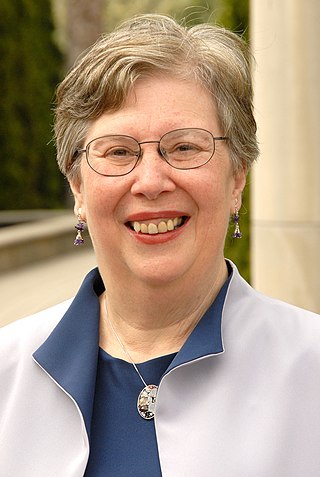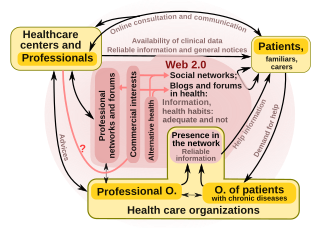
Social network analysis (SNA) is the process of investigating social structures through the use of networks and graph theory. It characterizes networked structures in terms of nodes and the ties, edges, or links that connect them. Examples of social structures commonly visualized through social network analysis include social media networks, meme spread, information circulation, friendship and acquaintance networks, peer learner networks, business networks, knowledge networks, difficult working relationships, collaboration graphs, kinship, disease transmission, and sexual relationships. These networks are often visualized through sociograms in which nodes are represented as points and ties are represented as lines. These visualizations provide a means of qualitatively assessing networks by varying the visual representation of their nodes and edges to reflect attributes of interest.

Comparative genomics is a field of biological research in which the genomic features of different organisms are compared. The genomic features may include the DNA sequence, genes, gene order, regulatory sequences, and other genomic structural landmarks. In this branch of genomics, whole or large parts of genomes resulting from genome projects are compared to study basic biological similarities and differences as well as evolutionary relationships between organisms. The major principle of comparative genomics is that common features of two organisms will often be encoded within the DNA that is evolutionarily conserved between them. Therefore, comparative genomic approaches start with making some form of alignment of genome sequences and looking for orthologous sequences in the aligned genomes and checking to what extent those sequences are conserved. Based on these, genome and molecular evolution are inferred and this may in turn be put in the context of, for example, phenotypic evolution or population genetics.
Scientometrics is the field of study which concerns itself with measuring and analysing scholarly literature. Scientometrics is a sub-field of informetrics. Major research issues include the measurement of the impact of research papers and academic journals, the understanding of scientific citations, and the use of such measurements in policy and management contexts. In practice there is a significant overlap between scientometrics and other scientific fields such as information systems, information science, science of science policy, sociology of science, and metascience. Critics have argued that over-reliance on scientometrics has created a system of perverse incentives, producing a publish or perish environment that leads to low-quality research.

Citizen science is scientific research conducted with participation from the general public. There are variations in the exact definition of citizen science, with different individuals and organizations having their own specific interpretations of what citizen science encompasses. Citizen science is used in a wide range of areas of study, with most citizen science research publications being in the fields of biology and conservation. There are different applications and functions of citizen science in research projects. Citizen science can be used as a methodology where public volunteers help in collecting and classifying data, improving the scientific community's capacity. Citizen science can also involve more direct involvement from the public, with communities initiating projects researching environment and health hazards in their own communities. Participation in citizen science projects also educates the public about the scientific process and increases awareness about different topics. Some schools have students participate in citizen science projects for this purpose as a part of the teaching curriculums.

Open research is research that is openly accessible by others. Those who publish research in this way are often concerned with making research more transparent, more collaborative, more wide-reaching, and more efficient. Open research aims to make both research methods and the resulting data freely available, often via the internet, in order to support reproducibility and, potentially, massively distributed research collaboration. In this regard, it is related to both open source software and citizen science.
The h-index is an author-level metric that measures both the productivity and citation impact of the publications, initially used for an individual scientist or scholar. The h-index correlates with success indicators such as winning the Nobel Prize, being accepted for research fellowships and holding positions at top universities. The index is based on the set of the scientist's most cited papers and the number of citations that they have received in other publications. The index has more recently been applied to the productivity and impact of a scholarly journal as well as a group of scientists, such as a department or university or country. The index was suggested in 2005 by Jorge E. Hirsch, a physicist at UC San Diego, as a tool for determining theoretical physicists' relative quality and is sometimes called the Hirsch index or Hirsch number.

Open science is the movement to make scientific research and its dissemination accessible to all levels of society, amateur or professional. Open science is transparent and accessible knowledge that is shared and developed through collaborative networks. It encompasses practices such as publishing open research, campaigning for open access, encouraging scientists to practice open-notebook science, broader dissemination and engagement in science and generally making it easier to publish, access and communicate scientific knowledge.
A mimotope is often a peptide, and mimics the structure of an epitope. Because of this property it causes an antibody response similar to the one elicited by the epitope. An antibody for a given epitope antigen will recognize a mimotope which mimics that epitope. Mimotopes are commonly obtained from phage display libraries through biopanning. Vaccines utilizing mimotopes are being developed. Mimotopes are a kind of peptide aptamers.
The myGrid consortium produces and uses a suite of tools design to “help e-Scientists get on with science and get on with scientists”. The tools support the creation of e-laboratories and have been used in domains as diverse as systems biology, social science, music, astronomy, multimedia and chemistry.

Head (vessel) Evidence for carbonates on Mars was first discovered in 2008. Previously, most remote sensing instruments such as OMEGA and THEMIS—sensitive to infrared emissivity spectral features of carbonates—had not suggested the presence of carbonate outcrops, at least at the 100 m or coarser spatial scales available from the returned data.

Helen Miriam Berman is a Board of Governors Professor of Chemistry and Chemical Biology at Rutgers University and a former director of the RCSB Protein Data Bank. A structural biologist, her work includes structural analysis of protein-nucleic acid complexes, and the role of water in molecular interactions. She is also the founder and director of the Nucleic Acid Database, and led the Protein Structure Initiative Structural Genomics Knowledgebase.

"Health 2.0" is a term introduced in the mid-2000s, as the subset of health care technologies mirroring the wider Web 2.0 movement. It has been defined variously as including social media, user-generated content, and cloud-based and mobile technologies. Some Health 2.0 proponents see these technologies as empowering patients to have greater control over their own health care and diminishing medical paternalism. Critics of the technologies have expressed concerns about possible misinformation and violations of patient privacy.
The concept of team science is a field of scientific philosophy and methodology which advocates using cross-disciplinary collaboration from diverse scientific fields to solve present-day problems. The field encompasses conceptual and methodological strategies aimed at understanding and enhancing the processes and outcomes of collaborative, team-based research.

PR domain zinc finger protein 9 is a protein that in humans is encoded by the PRDM9 gene. PRDM9 is responsible for positioning recombination hotspots during meiosis by binding a DNA sequence motif encoded in its zinc finger domain. PRDM9 is the only speciation gene found so far in mammals, and is one of the fastest evolving genes in the genome.
High-throughput sequencing of RNA isolated by crosslinking immunoprecipitation (HITS-CLIP) is a variant of CLIP for genome-wide mapping protein–RNA binding sites or RNA modification sites in vivo. HITS-CLIP was originally used to generate genome-wide protein-RNA interaction maps for the neuron-specific RNA-binding protein and splicing factor NOVA1 and NOVA2; since then a number of other splicing factor maps have been generated, including those for PTB, RbFox2, SFRS1, hnRNP C, and even N6-Methyladenosine (m6A) mRNA modifications.

Luís A. N. Amaral is a Portuguese physicist recognized for his research in complex systems and complex networks. His specific research interests include the emergence, evolution, and stability of complex social and biological systems. He is best known for his work in network classification and cartographic methods for uncovering the organization of complex networks. He is currently professor at McCormick School of Engineering and Feinberg School of Medicine, Northwestern University.

Filippo Menczer is an American and Italian academic. He is a University Distinguished Professor and the Luddy Professor of Informatics and Computer Science at the Luddy School of Informatics, Computing, and Engineering, Indiana University. Menczer is the Director of the Observatory on Social Media, a research center where data scientists and journalists study the role of media and technology in society and build tools to analyze and counter disinformation and manipulation on social media. Menczer holds courtesy appointments in Cognitive Science and Physics, is a founding member and advisory council member of the IU Network Science Institute, a former director the Center for Complex Networks and Systems Research, a senior research fellow of the Kinsey Institute, a fellow of the Center for Computer-Mediated Communication, and a former fellow of the Institute for Scientific Interchange in Turin, Italy. In 2020 he was named a Fellow of the ACM.
Metascience is the use of scientific methodology to study science itself. Metascience seeks to increase the quality of scientific research while reducing inefficiency. It is also known as "research on research" and "the science of science", as it uses research methods to study how research is done and find where improvements can be made. Metascience concerns itself with all fields of research and has been described as "a bird's eye view of science". In the words of John Ioannidis, "Science is the best thing that has happened to human beings ... but we can do it better."
Roberta Sinatra is an Italian scientist and associate professor at the IT University of Copenhagen. She is known for her work in network science and conducts research on quantifying success in science.
Brian Uzzi is an American sociologist and the Richard L. Thomas Professor of Leadership at the Kellogg School of Management, Northwestern University. He is known for his work on problems in the fields of sociology, network science, the science of science, and complex systems. He is the co-director of the Northwestern Institute on Complex Systems (NICO), is a professor of Sociology, and a professor of Industrial Engineering and Management Sciences at the McCormick School of Engineering. Since 2019, Uzzi has written a column for Forbes on Leadership and artificial intelligence.